| Path:Facelifeing Doctors>Professional Medical Care |
Dr. Noordhooff and Ching-wen Chang worked together to realize the idea they had back in the US and the result is the inception of Tamshui branch and Mackey Nursing College. They established the first intensive care unit, the first burn unit, and the first center for cleft lip and palate in Taiwan.
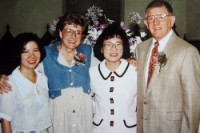
Dr. Noordhoff sponsored Chiu-yun Dai (second right) for her education in the nursing school. (1996)
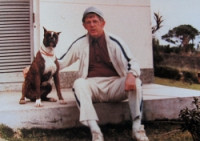
Dr. Noordhoff and his dog Brindy when they lived in Chuwei. (1971)
Elimination of Bribery
In the era when the medical resources were insufficient and there were not enough beds, patients had to give bribery to doctors for good medical care. Dr. Noordhooff believed that the elimination of bribery should start by increasing pays for doctors. He introduced the system of physician fees from the US and allowed extra incomes to doctors. There were signs posted throughout the hospital saying that “please help us not to take bribery”. Meanwhile, any doctors that took bribery or practiced outside would be fired without excuses.
True to His Words
Ching-wen Chang said that Dr. Noordhooff does to what he says. On one occasion, we went in the practice room and the doctor was seeing a patient. However, another patient was waiting outside.Dr. Noordhooff said nothing but told the doctor not to come back to the hospital the next day. He knew that talents are an important resource. He established the college system and nurtured the capability of students. He argued that only with specialism can the medical care improve. Dr. Noordhooff spent a total of 17 years in Mackay Memorial Hospital and sent 30 doctors to study overseas.
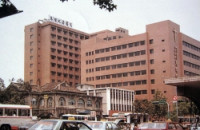
Mackay Memorial Hospital across three eras, from the old two-story building, to the white four-story building during the time of Dr. Noordhoff to the modern look today (from left to right).
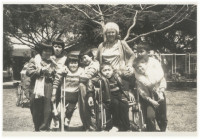
Poliomyelitis was once a nightmare in Taiwan.
Hospital Expansion
Mackay Memorial Hospital kept growing and all the beds and clinic centers had reached their maximum capacities. It was imperative to expand the scale. However, where was the funding source? Dr. Noordhooff flew back to the US and toured the churches with the pictures and slides of patients. Finally, his church, Reformed Church, denoted a total of $500,000. Without this donation, perhaps Mackay Memorial Hospital would not be what it is today.
Introduction of Salk Vaccine
In the 1950s and 1960s, poliomyelitis was a nightmare of the Taiwanese people. Some people crawled on the ground all their childhood. Some tied small stools on them to move along. In 1960, the US government decided to introduce the injection-based vaccine for poliomyelitis to oral intakes. Dr. Noordhooff thought it was a good idea to introduce the vaccine to Taiwan. With his efforts and the assistance from Church World Service, Salk vaccine was brought to Taiwan. In the following year, the Taiwanese government initiated a program to administer the vaccine throughout the island. By now, poliomyelitis was a term of yesterday in Taiwan.
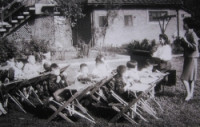
Establishment of Rehabilitation Center for Poliomyelitis Patients in 1964.
Establishment of the Rehabilitation Center for Poliomyelitis Patients
Poliomyelitis patients at that time were often stuck at home. In 1964, Mackay Memorial Hospital established the Rehabilitation Center for Poliomyelitis Patients by combining 3% of the hospital income and social resources to assist the children suffering from poliomyelitis.
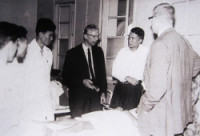
Dr. Noordhoff invited Dr. Brosma to Taiwan to instruct doctors in Makay Memorial Hospital. (1963)
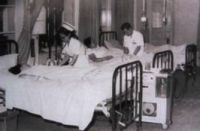
The first intensive care unit (ICU) in Taiwan.(1967)
First Treatment Center in Taiwan for Cleft lip and palate
One of the many surprises to Dr. Noordhooff in Taiwan was that he often saw adults with cleft lip and palate on the street. These people were never treated for their problems. At that time, he did not have sufficient training for the surgery so he invited Dr. Brosma from the US to demonstrate the skills. Dr. Noordhooff also went to the US for a two-year training program before he started to make new faces for the children with cleft lip and palate.
First ICU in Taiwan with 12 Beds
In 1967, Mackay Memorial Hospital established the first intensive care unit (ICU) in Taiwan, with a total of 12 beds. Dr. Noordhooff said that all the major US hospitals already had ICUs but not yet in Taiwan. He indicated that ICUs are important to critical patients. The patients are closely watched around the clock and well taken care off, in case of any emergency. All the other major hospitals followed suit by establishing ICUs after the first one in Mackay Memorial Hospital.
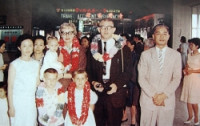
Feeling that his skills in repairing cleft lip and palate, Dr. Noordhoff took his family to the US to study. (1964)
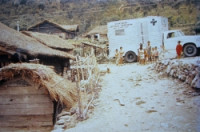
Dr. Noordhoff promoted medical treatments in the mountainous areas. (1967)
Establishment of the Burn Unit
In those days, there were a large number of burned patients. Any patient with over 30% skin burned would struggle to live. Dr. Noordhooff decided to establish a burn unit to make sure the patients receive sufficient care. At that time, the treatment of burned wounds was the least profitable business of the hospital. He went for speeches and fund raising by slowing the slides of burned children. In 1968, the first burn unit was established at Mackay Memorial Hospital. It became the beacon of hope for all the worst burned patients in Taiwan.
Touring Medical Treatments in Mountains
Taiwanese people were not well-off at that time. The poorest group was aboriginals living in the mountains. They could not afford medical treatments most of the times. Dr. Noordhooff decided to reach out to them, since they could not afford the hospital. With the assistance from the US churches, the hospital purchased a touring vehicle. The medical team was led by Dr. Noordhooff to offer free medical treatments in the mountain.
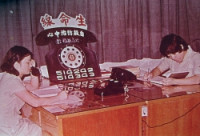
Dr. Noordhoff established Lifeline and Center of Suicide Prevention, to rescue many helpless souls. (1970)
First Center of Suicide Prevention and Lifeline
In 1967, Mackay Memorial Hospital estimated that it rescued over 600 suicide patients. Most of these patients were female. After one year of preparation, Dr. Noordhooff worked with Department of Psychiatry of National Taiwan University Hospital to establish Mackay Center of Suicide Prevention in 1969, the first of its kind in Asia. However, the question was how to prevent suicide committers from doing it again and how to bring back the people struggling to live. This is how Lifeline came about. In 1969, Mackay Lifeline was founded. After that, lifelines were established throughout Taiwan. Even Japan and Korea came to Taiwan to learn the lesson one and two years later.
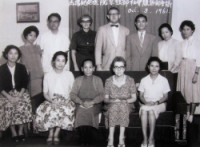
Mackay Memorial Hospital’s religious service department and social service department members .(1961)
Women’s Support Group
While Dr. Noordhooff was hustling in the hospital, Lucy also kept herself busy. She organized a monthly gathering at their home by inviting the wives of doctors and priests. The purpose was to network and contribute to the future of the hospital. This was how Mackay Women’s Support Group was formed. It was the first volunteer worker group serving at a hospital in Taiwan. At that time, the hospital was financially challenged and sometimes could not pay salaries on time. These women would try to make money for the hospital. They learned how to make artificial flowers, sell goods in shops and took pictures for the mothers who just gave birth. They used their earnings to fund the purchase of equipment for Mackay Memorial Hospital. Gradually, the hospital managed to increase the salaries for the staff, expanded operations and offered more beds. All the innovations made a huge impact in the medical field of Taiwan.
References :
Yu-fang Liang(2000).《Love, To Mend the Imperfectness: Dr. Noordhooff’s Forty Years in Taiwan》.Taipei City:Common Wealth .
Image Sources :
Yu-fang Liang(2000).《Love, To Mend the Imperfectness: Dr. Noordhooff’s Forty Years in Taiwan》.Taipei City:Common Wealth .
chinatimes blog http://blog.chinatimes.com/sunable/archive/2009/09/10/433209.html
